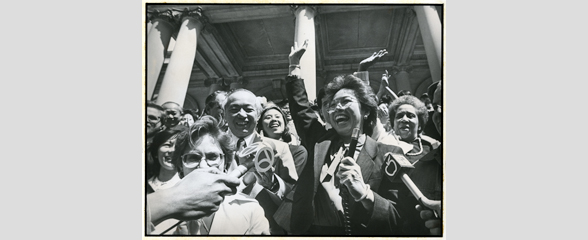 | Virginia Kee (b. 1932) was a long-time teacher at Junior High School 65, a co-founder of the Chinatown Planning Council (CPC), and a trailblazer in Chinatown and New York Democratic politics. In this oral history, Kee begins by recalling her childhood in New York Chinatown during the Depression years. She recounts the story of how her family got the Moshang last name, and describes her early schooling at PS 1 when it was mostly attended by the children of European immigrants. She recalls taking Mandarin classes at PS 1, which everyone seemed to be studying during World War II, as well as traveling on the "el" (elevated trains) to Chinese school at Huie Kin First Chinese Presbyterian Church. She also discusses the story of her father and mother and the circumstances of their immigration and marriage. Her father fled to Hong Kong and became a seaman after he cut his queue in defiance of the Qing government during the Manchu Rebellion. While on shore leave, he did not wake up in time to catch his ship and stayed on in New York, learning English quickly and becoming one the first bilingual salesmen at Cooks Restaurant Supplies, which sold to many Chinese Restaurants. Her mother, who was married at a young age to a man who shortly left China, insisted on coming to America to find him after waiting years for him to return to his home village. Her cousins, clerks at the Wing On Company, arranged for her to accompany a family with diplomatic status as an "ah mah" or nanny around 1910/1911. Finding that her husband had married an American woman, they agreed to a "Chinese divorce" and she worked for the Feng diplomat family until he was reassigned to Mexico in the mid-1920s. She reached out to the Zhongshan association for someone to marry, met Kee father, remarried and started raising a family when she was almost forty. Her father became owner of the Canton Restaurant on 11 Mott Street, which Virginia, her sister, and brothers all helped out at when they grew older. However, even with the whole family labor, they struggled during the recession following World War II. No longer able to make ends meet in Chinatown, her father decided to sell the restaurant and move the family to Charlotte, NC. Though she was allowed to attend Harry P. Harding High School, the white school, she describes her witness of the injustices of segregation as an education for her political thinking, which informed her work in the 1960s with CPC and her later work in the political arena. The oral history concludes with Kee sharing about her life after returning to New York from Charlotte. She worked while attending classes at night, slowly earning her BA and MA from Hunter College. She also married Herbert Kee, an engineer, and later, doctor. Lastly, she reflects on how not having children made her a bit different during her time and why she came to be involved in community work. This is the first of three interviews that MOCA staff conducted with Virginia Kee during the 1980s. |  | Virginia Kee (b. 1932) was a long-time teacher at Junior High School 65, a co-founder of the Chinatown Planning Council (CPC), and a trailblazer in Chinatown and New York Democratic politics. In this, the second of four interviews that MOCA staff conducted with Virginia Kee during the 1980s, Kee begins by discussing her early career while pursuing a bachelor and master degree at Hunter College. She then recounts her experience at her first job after graduation as the first Chinese American teacher at Junior High School 125 in Woodside Queens. This was during the time of Open Enrollment (1961-1963), when the Board of Education allowed for Black students to be bused in to majority-white schools as a means to appease parents pushing for more systematic efforts at school desegregation. Kee also describes how she later came to be permanently appointed to Junior High School 65 in Chinatown in 1965, how finding a lack of programs for the community youth led her to co-found CPC, and how constantly having to fight for funding for CPC because residents in Chinatown lacked political power led her to become involved in electoral politics. She briefly discusses other groups of which she was an active part, including United Democratic Organization, Community Board No. 3, the Council of Asian American Women, and New York State Teachers of a Second Language. The interview concludes with her reflections on childhood playtime with her siblings and the isolated life her family due to their Zhongshan roots, the changes she has noticed in Chinatown and her students over time, her first classes of students from Hong Kong and Mainland China, and the differences between these groups of students. | 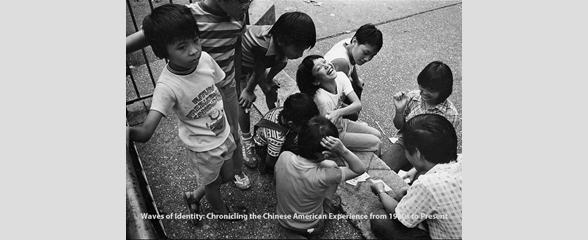 | This oral history, conducted in Cantonese with Alice Yip, was part of a greater effort by MOCA to research and record the history of Chinese Americans in the garment industry and was possibly conducted as part of MOCA’s research for its 1989 exhibition, “Both Sides of the Cloth.” Alice Yip, who grew up in Hong Kong, immigrated to the Netherlands in 1970 and then to the United States in 1976. She went to work immediately in the garment industry in New York Chinatown the day after arriving. She worked at the same factory as her mother-in-law, whom she partnered with to complete the hanging, sorting, packaging and tagging required of the last or finishing step in the garment production process. She worked at three different factories for a total of six years—three as a finisher and three as a sewing machine operator. Being sociable and bold, she was elected by fellow workers as union shop steward at all three factories. Later, she was hired as a union business agent of Local 23-25 of the International Ladies Garment Workers Union (ILGWU). In this oral history, Alice recounts her years of experience as a worker in the garment industry, covering such topics as her first day and week on the job, the work required in the finishing step of the process, why she switched to sewing, the differences between both kinds of work, her pay and hours, how she got her jobs, how she balanced garment work and childrearing, and her relationship with her children. She also speaks about her experience as a shop steward and a union business agent, why she joined the union, union health benefits, the changes she has seen in the garment industry since she first started in the 1970s, the goals she wants to accomplish through her union work, and what she would like to convey of this history to the next generations. | -OHMS_1724257872.jpg) | David Chin, a retired laundry worker, arrived in the United States in 1926 as the son of a US citizen. From gambling dens to laundromats, David describes working and living in New York City for most of his time in the United States. Other topics covered include his experiences during wartime (WW2) and housing discrimination during the postwar period. In the 1950s, David became involved with various Chinese laundry worker associations directly or indirectly. | 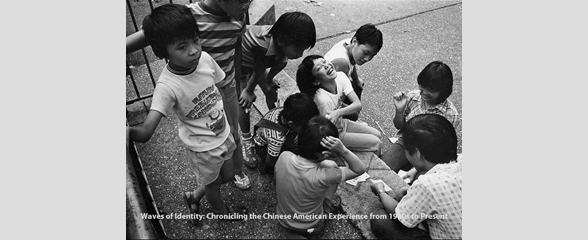 | David is a member of the New York Chinatown community who opened a laundry business before the Great Depression. He arrived in Chinatown in 1927, and exploring streets such as Bayard and Mott, observed a community with Chinese fabric stores, banks, drugstores, coffee shops, a theater, a dance hall, and a subway. Despite this economic vibrancy, areas such as Division Street were plagued by crime and instability.
David opened a laundry business that was successful at first, but it was severely impacted by the Great Depression in 1929, which detrimentally affected his operations and financial stability. The economic downturn prevented him from returning to China and intensified the challenges within the community. However, the strong sense of mutual support among Chinese grocery store owners helped many survive, ensuring no one went hungry despite the economic hardships.
David pointed out the existence of Jewish businesses in Chinatown and the difficulties experienced by Chinese grocers with limited English skills. Members of the community who learned English did so through Sunday schools and the neighborhood churches. Many laundrymen stayed in their laundries across the city and came to Chinatown on Sundays. They addressed the challenge of navigating the city with limited English language skills by providing cabdrivers with written addresses, counting lights and steps, and counting stops when taking the subway. David stressed the importance of being cautious, avoiding suspicious individuals, and relying on community support when necessary.
This interview is one of three conducted with David Chin in 1990. Please note that the audio quality is low in parts of the interview. | 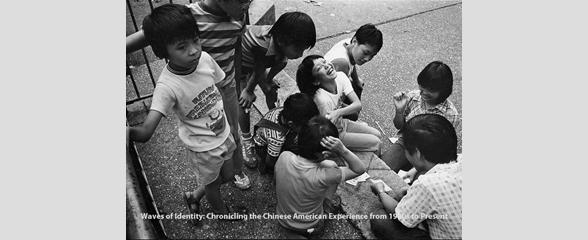 | In his youth, Donald Seeto played basketball on the Chinatown teams sponsored by the Chinese Athletic Club (CAC) (after 1946, the Chinese Community Club). Seeto was a member of the Midgets Basketball Team representing Chinatown’s Fifth Precinct, which won the Police Athletic League (PAL) New York City Basketball Championship undefeated for an impressive 25 straight games in 1945. In this oral history, Seeto shares memories of playing and later coaching CCC basketball during the 1940s. He talks the founding and funding of the Chinese Community Club (CCC) located at Pell Street, the CCC junior, intermediate and senior teams, the lively rivalry between CCC and other neighborhood teams, drawing 100-150 spectators to games played against Catholic teams in the Bronx, challenging Italian kids for the courts at Columbus Park, games and practices at the Church of All Nations during the 1940s, the shift to True Light Lutheran Church during the 1950s, the Intercity or Yupin Tournament organized for the Chinatown teams of New York, Philadelphia, Washington, and Boston to compete, the development of softball, girls basketball, and Japanese players during World War II. He also goes through photographs to identify various teams and teammates such as Newton Chin, Moody Chin, Richard Chin, Leong Gay Lee, James Mong Wu, Edmund Chin, Andrew Lung, and Stanley Chin of the CCC teams; David and Coolidge Mar of the Paxtons; a girls team called the Docks; Chinatown youth sports boosters such as Shavey Lee; and longtime CCC basketball coach Lung “Pop” Chin. | 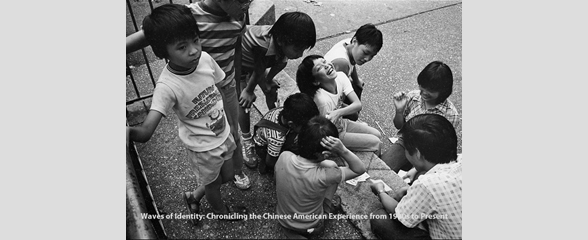 | This interview with Dr. Paul Chu (b. 1925) was conducted by an NYU graduate student who was working with the Chinatown History Project (now MOCA) to collect stories for a workshop on earlier generations of Italian American and Chinese American students at PS 23 (Public School 23). Paul, a dentist and longtime resident of Chinatown, grew up in Oakland’s Chinatown and moved to New York in the 1930s with his parents at the age of 8 or 9. His grandfather, a merchant in San Francisco, was the first to immigrate from the Guangdong area at around the turn of the century, followed by his grandmother. In the oral history, Paul shares his family’s immigration history as well as memories of growing up in Oakland, including living in a house with his extended family and the Chinese customs that his family followed. Asked to compare differences he perceived between Chinatown in New York and on the west coast, he notes that Chinese in New York were less Americanized and defines being Americanized as not only the outward appearance of looking American but also as the inner way that one thinks and feels and one’s tastes. Growing up in New York’s Chinatown, Paul recalls playing on Mott Street with friends, the neighborhood’s different Chinese and non-Chinese businesses, going to Baptist Church service on Pell Street with his mother, and attending Chinese school and PS 23. He also discusses applying for the mostly Jewish Seward Park High School and notes that all of his Chinese friends went on to high school, unlike his Italian classmates. Towards the end of the interview, Paul speaks about his two children and offers his thoughts on the changes in Chinatown today (1990). | 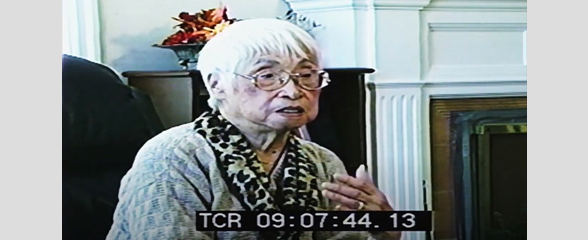 | There were two interviews recorded on this tape. In the first interview, Elsie Chang provides a personal view of Hazel Ying Lee, a female aviator who flew during the 1930s and 1940s. She discusses their close friendship, which began in China when they were young, and delineates the many fearless traits of her friend. Elsie also talks about her life in Portland and the discrimination she faced as an adult. She remembers the last time she saw Hazel and describes where she was when she first learned of her death. In a separate interview, Professor Jeffrey Barlow of Pacific University contextualizes racial and gendered landscape of early twentieth century Portland, Oregon and discusses the stereotypes and expectations with which Chinese American women such as Hazel would have had to contend. Prof. Barlow discusses how Hazel may have made the decision to become an aviator and how she was able to do so despite various constraints. These interviews are part of the Hazel Ying Lee & Frances M. Tong Collection and were conducted as part of the research and making of the documentary film, A Brief Flight: Hazel Ying Lee and the Women Who Flew Pursuit (2002), directed by Alan Rosenberg. | 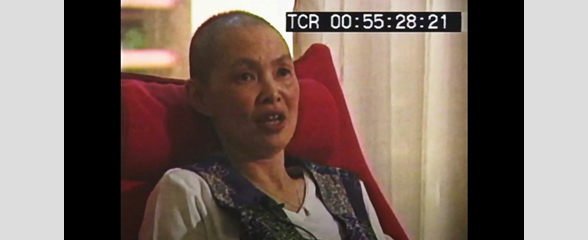 | Marjorie Lee, a librarian and archivist at the UCLA Asian American Studies Center, briefly discusses Hazel Ying Lee, a Chinese American woman pilot who flew in the 1920s and 30s. She shares her insights into the flying club established by the Chinese community to express their patriotism before World War II, and contextualizes the decision of Hazel to pursue aviation within the historical gender norms of the times. This interview is part of the Hazel Ying Lee & Frances M. Tong Collection and was conducted as part of the research and making of the documentary film, A Brief Flight: Hazel Ying Lee and the Women Who Flew Pursuit (2002), directed by Alan Rosenberg. | 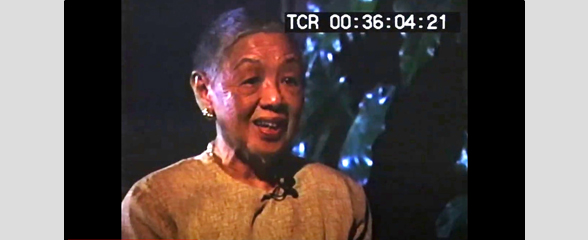 | Frances M. Tong is the sister of Hazel Ying Lee, a Chinese American female aviator who served in the WASP (Women Airforce Service Pilots) program during World War II. In this portion of the interview, Frances discusses various topics in relation to Hazel, including her immigration and that of her siblings to Hong Kong, her stance on office work versus homemaking, the difficulty Chinese American women had with breaking into office professions and working outside the home, the different roles in a Chinese family, and her admiration for her sister, Hazel. This interview is part of the Hazel Ying Lee & Frances M. Tong Collection and was conducted as part of the research and making of the documentary film, A Brief Flight: Hazel Ying Lee and the Women Who Flew Pursuit (2002), directed by Alan Rosenberg. |



-OHMS_1724257872.jpg)





